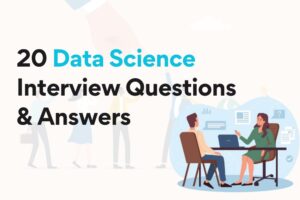1. Understanding Data Fundamentals
1.1. Types of Data
- Structured vs. Unstructured Data: Unstructured data, on the other hand, includes everything from social media posts to videos—no strict organization.
- Qualitative vs. Quantitative Data: Qualitative data describes attributes or characteristics (like colors or names), while quantitative data can be measured (like heights or weights).
- Time-Series Data: Recognizing patterns in time-series data can reveal trends and help in forecasting.
Explore further and deepen your knowledge and skills with our Data Science course in Pune.
1.2. Data Collection Techniques
Every data scientist knows that good analysis starts with good data.
- Methods of Data Collection: Each method has its strengths depending on what you want to learn.
- Sampling and Population: Understanding different sampling techniques (random, stratified, etc.) is vital to ensure that your data reflects the population without unnecessary bias.
- Ethical Considerations: Always keep ethics in mind. Respect privacy and ensure your data collection methods are transparent and fair.
1.3. Introduction to Data Storage
Data needs a home where it can be stored, managed, and accessed.
- Overview of Databases: You will learn about relational databases (like MySQL) that organize data into tables and non-relational databases (like MongoDB) that store unstructured data more flexibly.
- Basic Principles of Data Warehousing: Data warehousing involves aggregating large volumes of data from different sources for reporting and analysis.
- Understanding Data Formats: You will encounter various data formats such as CSV for simple tabular data, JSON for structured data interchange, and XML for web-based data. Each format has its use cases depending on your project needs.
2. Data Cleaning and Preprocessing
2.1. Handling Missing Data
Not all datasets are perfect, and missing data can skew your results.
- Techniques for Imputation: Learn how to fill in missing values using various techniques like mean substitution or more advanced methods.
- Identifying Missing Data Patterns: Understanding why data is missing (completely at random vs. not at random) helps in choosing the right strategy.
- Impact on Analysis: Realize how missing data can bias your findings—being aware of this can save you from drawing misleading conclusions.
2.2. Data Transformation
Before diving into analysis, data often needs some cleaning and reformatting.
- Normalization and Standardization: You will understand why these processes are essential for making your data consistent, especially when working with different units.
- Data Encoding Techniques: As data types convert during analysis (for instance, turning categorial data into numerical via one-hot encoding), knowing various encoding methods is key.
- Data Scaling Methods: Scaling allows models to treat all features equally.
2.3. Outlier Detection and Treatment
Outliers can provide insights or mislead your analysis.
- Identifying Outliers
- Handling Outliers: Whether you choose to remove them or transform them, you’ll discuss how to deal effectively with outliers to maintain the integrity of your analysis.
- Implications for Data Interpretation: Understanding how outliers can distort your results will be a valuable insight as you analyze your data.
3. Exploratory Data Analysis (EDA)
3.1. Data Visualization Techniques
Visuals make data digestible.
- Overview of Data Visualization Tools:
- Principles of Effective Visual Communication: Discover how to visualize data effectively—choosing the right chart for your data type is critical.
- Role of Dashboards and Reports: Learn how dashboards can summarize information and how well-designed reports can make your insights clear and actionable.
3.2. Summary Statistics
Statistics provide a foundation for deeper analysis.
- Importance of Mean, Median, and Mode
- Correlation and Covariance: Understand relationships between variables—are they positively, negatively, or not at all related?
- Using Summary Statistics: Utilize these stats as a launching point for deeper exploration of your data.
3.3. Identifying Patterns and Trends
Patterns in data can tell compelling stories.
- Analyzing Distributions: Learn to recognize the shape of your data distribution—normal, skewed, etc., which is crucial for choosing the right analysis technique.
- Identifying Trends Over Time: Use statistical methods and visualizations to spot trends, helping make predictions about future data points.
- Importance of Segment Analysis: By segmenting your data, you’ll uncover more tailored insights that might be hidden in the overall data.
4. Machine Learning Fundamentals
4.1. Introduction to Unsupervised Learning
Here, you won’t be guiding the algorithm.
- Overview of Clustering Techniques: Dive into methods like K-means and Hierarchical clustering, useful for pattern recognition in ungrouped data.
- Dimensionality Reduction Methods: Techniques like PCA and t-SNE will help simplify your datasets while retaining essential information.
- Real-World Applications
4.2. Model Evaluation and Tuning
Perfecting your model can make all the difference.
- Cross-Validation Techniques: Learn about techniques to assess your models’ effectiveness on unseen data, ensuring they generalize well.
- Challenges of Overfitting and Underfitting: Understand these challenges and how to strike a balance for optimal model performance.
- Importance of Hyperparameter Tuning: Discover strategies to fine-tune your model settings for the best outcomes.
5. Real-World Applications and Case Studies
5.1. Industry-specific Applications
Data science isn’t just theory; it’s application.
- Healthcare and Pharmaceuticals: Learn how predictive analytics can aid in patient care and drug development.
- Marketing and Customer Analytics: Discover how companies utilize data science for targeted marketing campaigns and improving customer experience.
- Financial Modeling and Risk Assessment: Understand how banks assess risks and predict market trends using data.
5.2. Case Studies of Successful Data Science Projects
Real examples illustrate the skills learned.
- Notable Data Science Projects: Case studies like Netflix’s recommendation engine show the practical impact of data science.
- Lessons from Failures: Acknowledge that not all data science initiatives succeed, which can be informative to learn from mistakes and missteps.
- Ethical Considerations
5.3. Communicating Results Effectively
Sharing findings is as important as obtaining them.
- Best Practices for Reporting Findings: Learn how to present your results clearly and concisely—visual aids can be your best friend here.
- Importance of Storytelling with Data: Crafting a compelling narrative around your data can significantly enhance comprehension and retention.
- Making Technical Content Accessible: Develop skills to communicate complex findings to non-technical audiences without losing the essence of your insights.
Conclusion
In a data science course in Pune, you’ll acquire a robust set of skills ranging from understanding data fundamentals to applying machine learning techniques. Embracing these skills opens doors across various industries, making data science not just a career but a pathway to impactful decision-making. Whether you’re aiming to boost your career or simply interested in data science, these skills will serve you well in the ever-expanding universe of data-driven insights.






